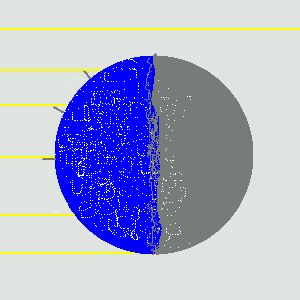
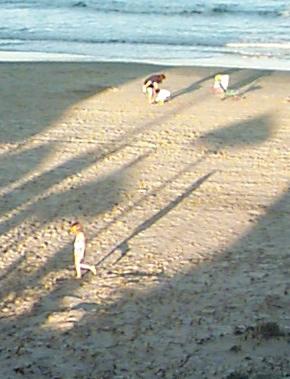
We don't usually notice shadows but they are everywhere. Sometimes they work for us (the shade under a beach umbrella is a welcome escape from the heat of the sun). Sometimes they are a nuisance (it's hard to read when a shadow is cast across your book). A lot that is done to illuminate the home, the workplace, or the sports arena is an attempt to eliminate shadows, and yet we plant trees and install drapery and awnings to make shadows.
We begin the study of light with shadows, because they are easily
observed and lend themselves well to prediction, measurement and data analysis.
They have a behavior that is not entirely simple but which can be completely
understood knowing that light travels in a straight line.
Although this seems to be a simple concept,
its implications are deep and affects practically everything
we see. Also, understanding and predicting where light will go and
what the result will be is a necessary tool for understanding other important
concepts such as reflection and refraction.
Applications of shadows
The X-ray images of teeth, bones, and the contents of your carry-on bag
are shadows, made by a kind of light that goes through most things, but
is scattered more by dense materials such as metals.

A sundial is a way to measure the position of the sun (and thus determine the time) by observing its shadow.
The first measurement of the size of the earth was based on the length of shadows exactly at noon in different places. For the shadow lengths to be very different, you have to go north a significant fraction of the radius of the earth. Observing the shadow lengths allows the size of the earth to be calculated.
During an eclipse of the sun, we are briefly in the shadow of the moon; during an eclipse of the moon, it is passing through the earth's shadow. The duration of the eclipses was one of the first hints to early astronomers that the moon is smaller than the earth (but not a lot smaller) and that its distance from earth is about 100 earth-diameters -- much less than the distance to the sun.
There is another kind of astronomical shadow that played an important role. About every 100 years, the planet Venus passes directly in front of the sun, so that it appears as a small dark region on the sun's disk. From different places on the surface of the earth, we get different views, and the path of Venus across the sun's disk is slightly different. This provided the first way that astronomers could measure the distance from the earth to the sun. The reason that Captain Cook sailed to the South Pacific (accidentally discovering New Zealand on the way) was to make the transit of Venus that occurred in 1769.
Everyday shadows
Our shadow dutifully follows us around, and we hardly ever notice it.
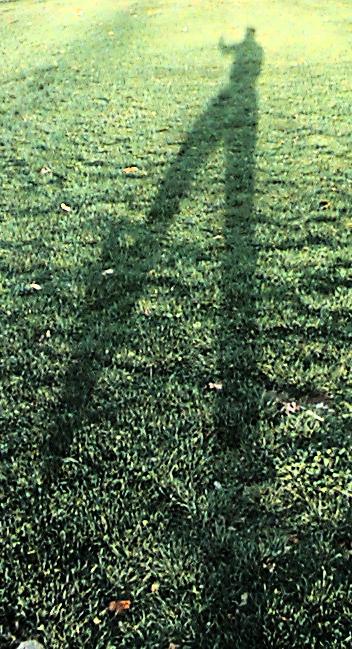
Sometimes it looks funny (for a discussion, go here).
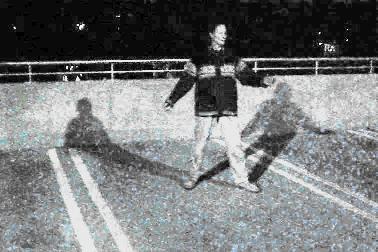
Sometimes we have more than one!
If you sit in the window seat in an airplane, you can look for the shadow
of the airplane on the ground. The shadow should be about the same size
as the airplane -- about as big as a barn. Barns are hard to see from
several miles up, too. However, the shadow of the plane is also
hard to see because it is fuzzy.
That's because (as we found out with the flagpole) the sun looks
like a disk, not a dot, and the beams of light coming from the
top and bottom edges of the sun are travelling slightly different
directions.
The effect becomes more
prominent as the object making the shadow gets farther from the surface
on which the shadow is cast. When the airplane is miles
high, the shadow is very fuzzy and hard to see.
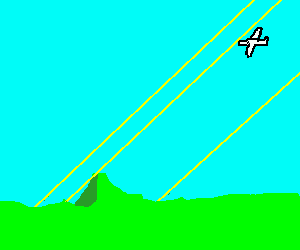
However, you will see something else: the ground is slightly brighter right where the airplane shadow is supposed to be! The reason for this is that you are looking right along a sun beam, and from this point of view you cannot see the shadows that objects on the ground cast behind them -- you see only their brightly illuminated front side. In the sketch, the people in the airplane cannot see the shadow on the back side of the hill. This effect is most prominent when the surface is rough, so that there are lots of shadows. (This is also the explanation why the full moon is very much brighter than at other phases.)
Return to the summary of light topics